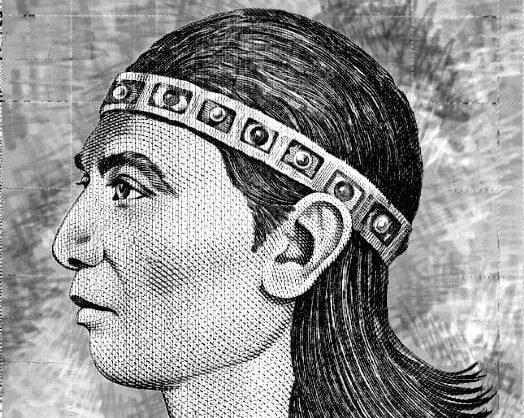Native Americans refer to all the peoples and civilizations of the Americas (North, Central, South, Caribbean and various islands. This includes the natives of Alaska and Greenland to Tierra del Fuego. There would be about a thousand different languages and cultures.
Here are the major linguistic and cultural currents: such as the Algic languages (including Algonquin), Uto-Aztecan (including Nahuatl) mainly in North America; Mayan languages (including Quiché), Oto-Mango (including Coatzospan Mixtec) mainly in Central America and Mexico; the Arawakian languages (including Wayuu), Tupi (including Guarani), Quechua (including Cuzcanian Quechua) mainly in South America, as well as isolated languages.
Several indigenous languages have developed their own writing, such as the Mayan languages or Nahuatl. Many later adopted the Latin alphabet or designed a script more suited to their particularities. There are mostly settler writings on Native American customs.

Contenus
ToggleFestivals of the Peoples of the Americas
Holidays of the month
July 4, 2024 (1 event)
–
July 4, 2024
On this day, the Aztecs began the month of Huey Tecuilhuitl in honor of the Great Lords Xilonen and Cihuacoatl (of mothers and fertility). Xilonen was the goddess of seven serpents, nurturing mother, agriculture, corn and women. During the festival, her priestesses designate the seed corn to be planted in the coming season. To appease the deity, as well as to ask for a good harvest, priests often engaged in child sacrifice. #mythology #myth #legend #calendar #2August #HueyTecuilhuitl #Xilonen #Aztec
July 9, 2024 (1 event)
July 9, 2024

Today, the different tribes of northern Canada in Nunavut celebrate their national day. It is an opportunity to show their culture and to compete in traditional games between tribes. #mythology #myth #legend #calendar #9July #nunavut
July 14, 2024 (1 event)
–
July 14, 2024
On this day, the Aztecs celebrated the beginning of the month of Tlaxochimaco in honor of Huitzilopochtli the god of war. This festival signifies the outpouring or the birth of flowers. Major god of Aztec mythology, many sacrifices are made throughout the year, punctuating life in the capital Tenochtitlan. #mythology #myth #legend #calendar #August 20 #Tlaxochimaco #Huitzilopochtli
July 20, 2024 (1 event)
July 20, 2024

Today, Honduras commemorates Lempira, the last leader of the Lenca people. Lempira symbolizes Native American resistance against the Spanish conquest in Honduras. The national currency, the lempira, bears his name. #mythology #myth #legend #calendar #July 20 #honduras #lenca #lempira
July 26, 2024 (1 event)
–
July 26, 2024
On this day, the Mayans celebrated the new year (according to the Haab solar calendar). This marks the beginning of a new cycle and a new "personality" or essence for the coming year, signaled by its own sign or glyph such as Seed, Monkey, Storm, etc. However, the timeless day of July 25 is perhaps more important to the Mayans than July 26, in that it is a day to give thanks and reflect on what has been accomplished and what lessons are to be learned. #mythology #myth #legend #calendar #July 26 #New YearMaya
Cultural areas in the Americas
Until recent decades, the late settlement theory prevailed, which maintains that human beings migrated to America from Asia via Beringia during the last ice age 12,000 to 14,000 years ago. However, traces indicating the presence of humans in the northern Yukon 24,000 years ago have been found. These data would suggest the crossing of humans from Siberia who would have occupied the now submerged territories of Beringia, and would have remained isolated by the glaciers some 8,000 years before dispersing in the rest of the American continent.
Scientists also support the thesis according to which the first settlement of America would have occurred 20,000 to 50,000 years earlier and would also be the result of a migration during which the human being would have taken different routes, such as as Mongolia, Siberia and the Arctic Ocean sea ice.
Subsequently, humans quickly occupied the entire continent where they formed various societies: in North America, the civilization of Mississippi and the city of Cahokia, the Iroquoian villages of Hochelaga and Stadaconé, as well as the Inuit, Dorset and Saqqaq cultures. In South America, the sacred city of Caral-Supe (the oldest American city) and the Sacred Valley of the Incas; in Mesoamerica, the Mayan cities of Chichén Itzá and Yaxchilan and the Aztec capital of Mexico-Tenochtitlan.
The Viking colonization of America is the first well-documented attempt at human settlement from Europe. According to the saga of Erik the Red, the first colonies were established in Greenland around the year 985 CE. His son, Leif Ericson, would then have explored Vinland (island of Newfoundland) around the year 1000 and would have entered into a relationship with the Beothuks. However, other pre-Columbian trans-oceanic contacts are presumed to have occurred even before the Scandinavian explorations.
The most developed civilizations of America, at the time of their encounter with Europeans, were not so technologically advanced as those of the Old World. For example, they had not developed the technology of the wheel and metallurgy had almost never any use other than decorative or monetary (notably in the form of coin axes): moreover, most Amerindians did not did not use a writing system, except in Mesoamerica, where they have been found on monuments as well as in codices.
However, this backwardness did not apply to all areas: certain American civilizations achieved a high degree of social organization and developed remarkable knowledge of astronomy and mathematics, as well as complex techniques of agriculture and architecture; thus, for example, the Aztec capital, Mexico-Tenochtitlan, was, when the Spaniards discovered it, one of the largest cities in the world, with an estimated population of about 200,000.




